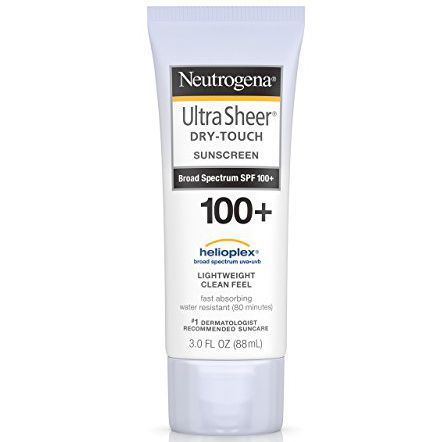Spf 15 Sheer Coverage Continuous Spray Sunscreen
This article was medically reviewed by Heather Woolery-Lloyd, MD, a board-certified dermatologist and member of the Prevention Medical Review Board , on April 30, 2019.
You know you need to apply sunscreen daily, but choosing the best one to protect your skin can be confusing, especially when it comes to SPF. Do you go for SPF 30, 50, or all-out 100?
The short answer: When in doubt, more is more. Even though applying SPF 100 instead of SPF 50 only boosts your protection slightly, that buffer can add up over time and "reduce the accumulation of chronic UV damage that is linked to non-melanoma skin cancer and aging," Dendy Engelman, MD, board-certified dermatologic surgeon at Medical Dermatology & Cosmetic Surgery in New York City.
More From Prevention

On the flip side, SPF 100 tends to make people feel rather invincible in the sun—which can lead to misuse. So, what's the deal? Here's everything you need to know about SPF 100, who should use it, and how to apply it the right way.
Back up: What does SPF mean, anyway?
SPF stands for sun protection factor. This number is found on the front of your sunscreen bottle, and it refers to the amount of time the sun's UV rays—mainly UVB rays, which are responsible for sunburn—need to redden your skin compared to the amount it would take if you weren't wearing any at all, according to the Skin Cancer Foundation. So when you apply SPF 30 properly, it would take 30 times longer for your skin to burn.
But why are there so many different SPF numbers to choose from? It's a little complicated, but here's the breakdown:
- SPF 15 blocks 93 percent of UBV rays
- SPF 30 blocks 97 percent of UBV rays
- SPF 50 blocks 98 percent of UVB rays
- SPF 100 blocks 99 percent of UBV rays
While SPF 30 and 50 provide adequate protection for the average person, "if you burn easily or are planning to spend all day in the sun, I would recommend a higher SPF," says Dr. Engelman.
Does that mean SPF 100 is actually more effective?
Yes, there is strength in numbers. In one 2018 study published in Journal of the American Academy of Dermatology, researchers had nearly 200 healthy adult men and women wear SPF 100+ on half of their face and SPF 50+ on the other half. Then, they had the participants spend time outside, rather than testing them in a lab. The result? The SPF 100+ sunscreen was significantly more effective in protecting against sunburn than SPF 50+ during the real-word test.
Wearing a higher SPF is especially important if you are spending time in direct sunlight, planning on sweating or swimming, or have a family history of skin cancer.
"When you participate in moderate outdoor activities such as jogging on a very hot day, the heat from your activity and surroundings can increase the sensitivity of your skin, and higher SPF protection is needed in order to prevent acute sunburn," says Dr. Engleman, "so it's always best to reach for the highest levels."
Still, the efficacy of any sunscreen you choose doesn't depend on SPF alone. The way you apply the product matters, too.
Do you still need to reapply SPF 100?
Yes, and here's where most people get into trouble. SPF 100 tends to get a bit of an eye-roll from some researchers because studies show the number gives people a false sense of security, according to the Environmental Working Group, ultimately causing them to not apply as much or often as they should.
Bottom line? Just because SPF 100 gives you a high level of protection at first, doesn't mean you should skimp on the amount you apply—or how often you reapply.
"Because the protection afforded by sunscreen begins to wear off after lengthy exposure to the sun—not to mention, sunscreen rubs off with normal activity—it needs to be reapplied at least every 2 hours, no matter what SPF level you are using," says Dr. Engelman.
High SPF alone is not enough, she emphasizes. It's also important to choose a broad-spectrum sunscreen (to protect against both UVA and UVB damage), apply at least 1 ounce (or a shot glass-sized amount) to your body, and reapply immediately after swimming or sweating, too.
You should also wear protective clothing, such as wide-brimmed hats, beach cover-ups, longer sleeves when possible, and sunglasses when possible, says Dr. Engleman.
Stay updated on the latest science-backed health, fitness, and nutrition news by signing up for the Prevention.com newsletter here . For added fun, follow us on Instagram .
Paige Stables is the Assistant Beauty Editor at Good Housekeeping, Woman's Day and Prevention magazines, all part of the Hearst Lifestyle Group; she has also written for Cosmopolitan, Seventeen, Redbook, Dr. Oz, and Brides. She received a Bachelor of Arts in Communication Studies from the University of San Diego in California, during which time she logged internships at Vogue and San Diego Magazine. When not swiping on the latest lipstick or spritzing a fabulous new fragrance find, Paige can be found picnicking in Central Park, planning her next travel adventure, or admiring art and fashion installations at one of the many museums in the city. She is based in Manhattan, New York.
thornburgpecassoo1997.blogspot.com
Source: https://www.prevention.com/beauty/skin-care/a27227721/spf-100-sunscreen/

Postar um comentário for "Spf 15 Sheer Coverage Continuous Spray Sunscreen"